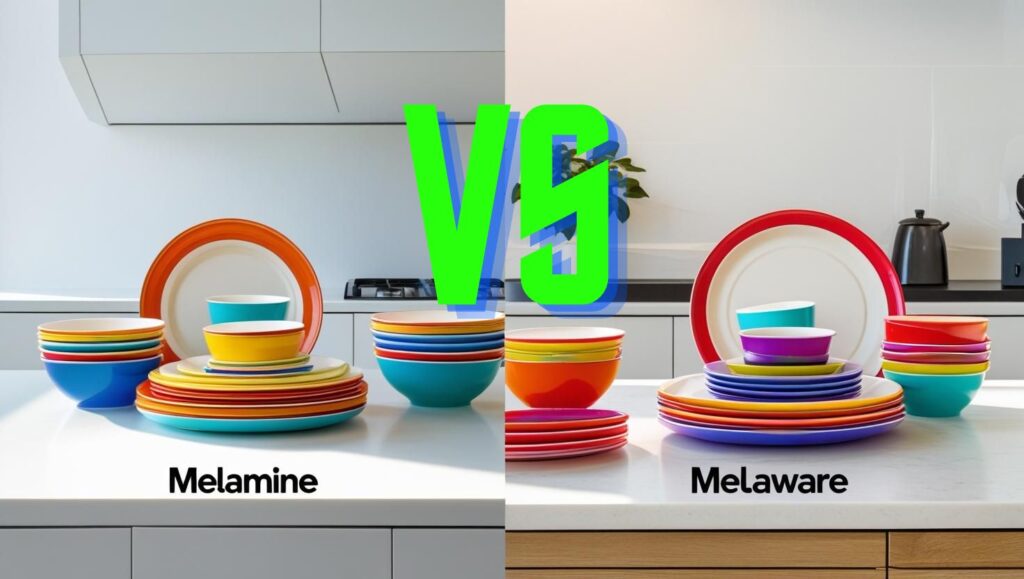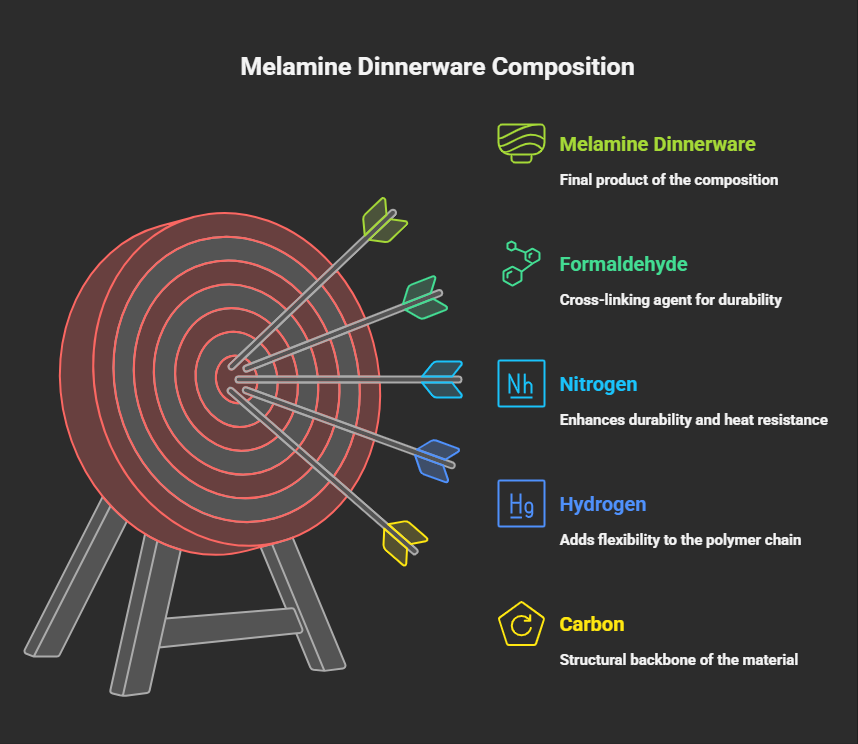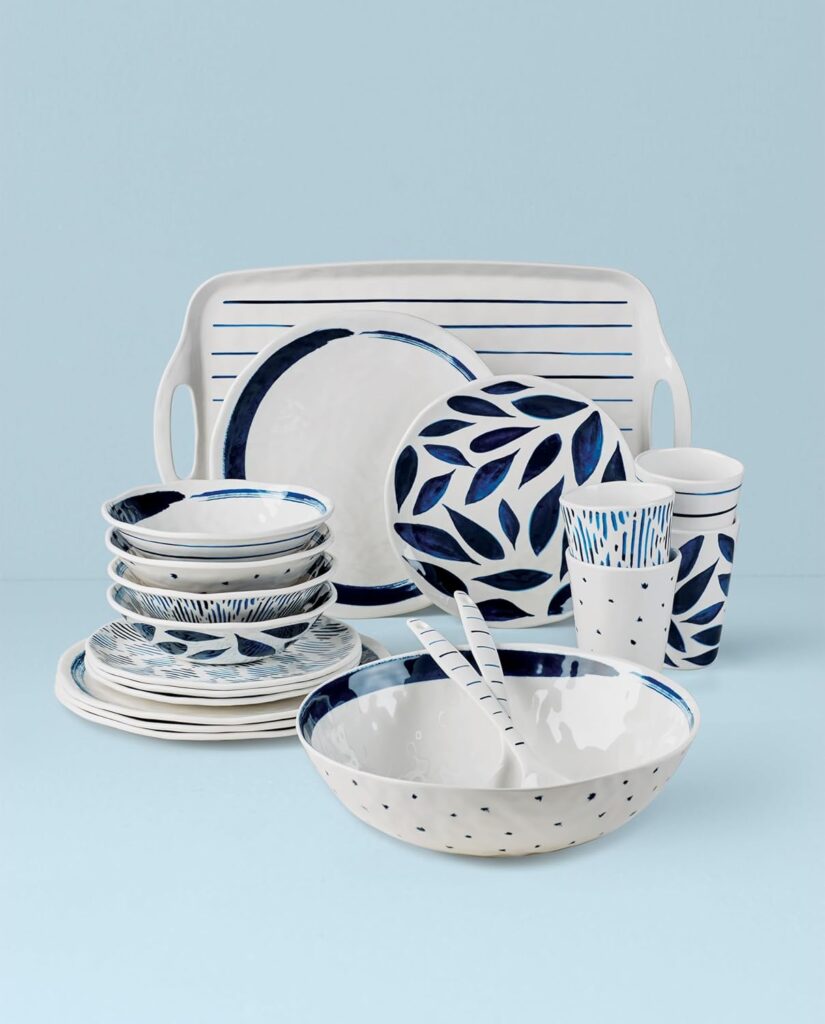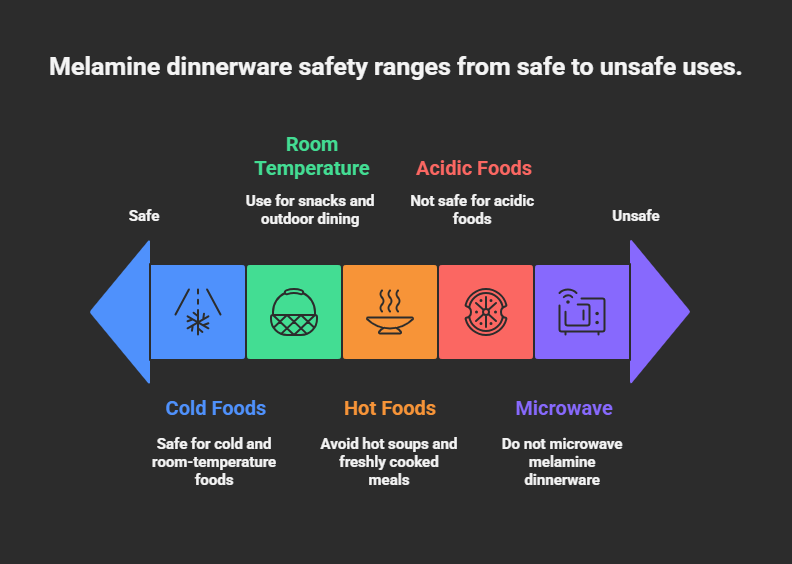You’re standing in the dinnerware aisle, staring at two nearly identical sets of plates. One says “melamine,” the other “melaware.” Same bright colours, same lightweight feel, but different prices.
Which one should you choose? Are they even different?
This confusion happens to thousands of shoppers every day. You want something that won’t break when your kids drop it.
You need plates that are light enough for camping trips. But you also worry about safety, especially after hearing scary stories about plastic dishes in microwaves.
The melamine vs melaware dinnerware confusion isn’t just about names. It’s about making the right choice for your family’s health and your wallet.
You deserve to know what you’re actually buying, whether it’s safe to use, and how to care for it properly.
Here’s everything you need to know to make the smart choice.
MELAMINE VS MELAWARE: CLEARING THE CONFUSION

Now, here’s where things get interesting. Melaware vs melamine isn’t actually a battle between two different materials. It’s more like comparing
“tissues” to “Kleenex” – one’s the generic term, the other’s a brand name.
Melaware is essentially melamine dinnerware marketed under a specific brand or product line. The confusion arises because some manufacturers use “melaware” as a catchy marketing term to differentiate their products.
However, the fundamental material remains the same: melamine-formaldehyde resin.
Why the Naming Confusion Exists
Several factors contribute to this naming puzzle:
- Marketing strategies – Brands create unique names to stand out
- Regional variations – Different countries may use different terms
- Quality grades – Some companies use distinct names for premium lines
- Consumer perception – “Melaware” might sound more sophisticated than “melamine”
The truth is, whether you’re buying melamine or melaware, you’re getting the same basic material. The differences lie in manufacturing quality, design, and brand reputation rather than the core composition.
MATERIAL COMPOSITION DEEP DIVE
Understanding what goes into your durable dinnerware materials helps you make informed decisions. Let’s break down the science without getting too technical.

Chemical Makeup
Melamine dinnerware consists of:
- Carbon – Provides structural backbone
- Hydrogen – Adds flexibility to the polymer chain
- Nitrogen – Contributes to durability and heat resistance
- Formaldehyde – Acts as a cross-linking agent

The exact composition varies between manufacturers. However, quality melamine typically contains higher nitrogen content, resulting in better durability and safety.
Manufacturing Process
The creation of melamine resin dinnerware involves several steps:
- Mixing – Melamine powder combines with formaldehyde
- Pressing – The mixture goes under high pressure and heat
- Moulding – Shaped into desired dinnerware forms
- Curing – Heat treatment ensures complete polymerisation
- Finishing – Surface treatments and quality checks
This process creates a material that’s significantly stronger than regular plastic whilst remaining lightweight, Break-resistant, having vibrant colours with smooth surface and affordable.
SAFETY CONSIDERATIONS: THE TRUTH ABOUT MELAMINE
When it comes to melamine dishes safety, there’s quite a bit of misinformation floating around. Let’s separate fact from fiction with some straight talk.
Microwave Safety: The Hard Truth
Is melaware microwave safe? The answer is a definitive no. Neither melamine nor melaware should ever go in the microwave. Here’s why:
- Heat sensitivity – Melamine begins to break down at temperatures above 70°C
- Chemical release – High temperatures can cause formaldehyde migration
- Warping risk – The material can deform and become unusable
- Fire hazard – Overheating can lead to melting or burning
The FDA has been crystal clear on this point. Only ceramic or specifically marked “microwave-safe” materials should be used for heating food.
Even brief microwave exposure can compromise the integrity of melamine dinnerware.
Food Safety Guidelines
Food-safe plastic dishes must meet specific standards. Quality melamine dinnerware is generally safe for cold and room-temperature foods. However, certain precautions apply:

Safe uses:
- Cold salads and desserts
- Room temperature snacks
- Outdoor dining and picnics
- Children’s meals (non-heated)
Avoid these situations:
- Hot soups or stews
- Freshly cooked meals
- Acidic foods (which can accelerate chemical migration)
- Microwave heating.
DISHWASHER SAFETY: GOOD NEWS AT LAST
Unlike microwave use, melaware dinnerware is generally dishwasher safe. This makes cleanup a breeze, especially after large gatherings.
Proper Dishwasher Care
Follow these guidelines for optimal results:
- Use gentle cycles – Avoid high-temperature wash settings
- Skip heated dry – Air dry instead to prevent warping
- Load carefully – Secure items to prevent bouncing and scratching
- Use mild detergent – Harsh chemicals can dull the finish
The key is avoiding extreme temperatures. Most modern dishwashers have eco-friendly cycles that work perfectly with melamine.
Hand Washing Tips
For daily care, hand washing often works best:
- Use warm (not hot) water
- Apply mild dish soap
- Scrub gently with soft sponge
- Rinse thoroughly
- Air dry completely
Avoid abrasive cleaners or scouring pads, as they can scratch the surface and create harbours for bacteria.
PROPER CARE AND MAINTENANCE
Maintaining your melaware lightweight dinnerware properly extends its lifespan and keeps it looking fresh. Here’s your complete care guide.
Daily Maintenance:
Cleaning instructions for melamine are straightforward:
- Immediate cleaning – Don’t let food residue sit too long
- Gentle scrubbing – Use soft cloths or sponges only
- Thorough rinsing – Remove all soap residue
- Complete drying – Prevent water spots and bacterial growth
What to Avoid:
Certain practices can damage melamine dinnerware:
- Abrasive cleaners – Scratch the surface
- Bleach solutions – Can cause discolouration
- High heat exposure – Warps and damages the material
- Sharp utensils – Create scratches that harbour bacteria
- Acidic foods – Can cause etching over time
Storage Tips:
Proper storage prevents damage:
- Stack carefully – Use protective pads between plates
- Avoid weight – Don’t overload stacks
- Store in cool, dry places – Prevent warping
- Keep away from heat sources – Ovens, radiators, direct sunlight.
MELAMINE VS OTHER DINNERWARE MATERIALS
Let’s compare melamine vs ceramic dinnerware and other popular options to help you make the best choice.
Comparison Table
| Material | Weight & Durability | Safety Features | Cost & Maintenance |
| Melamine | Light & break-resistant | Dishwasher safe, NOT microwave safe | Low cost, easy care |
| Ceramic | Heavy but fragile | Microwave & dishwasher safe | Medium cost, careful handling |
| Porcelain | Medium weight, delicate | Microwave & dishwasher safe | High cost, premium quality |
| Stoneware | Heavy & very durable | Microwave & dishwasher safe | Medium cost, long-lasting |
WHEN TO CHOOSE MELAWARE OR MELAMINE
Commercial dinnerware options often include melamine for good reasons:
- Outdoor dining – Lightweight and unbreakable
- Children’s meals – Safe from breaking hazards
- Casual entertaining – Stylish without the worry
- Travel and camping – Easy to pack and transport
- High-volume use – Cost-effective for restaurants
When to Choose Alternatives
Consider ceramic or porcelain when:
- Microwave use is essential
- Hot food service is primary use
- Formal dining requires elegant presentation
- Long-term investment is the priority.
WHAT IS ANOTHER NAME FOR MELAMINE?
Melamine is also known as melamine-formaldehyde resin, thermosetting plastic, or in some cases, branded names like “melaware.” The scientific name is 2,4,6-triamino-1,3,5-triazine.
IS MELAMINE DINNERWARE COMPLETELY SAFE?
Melamine dishes safety depends on proper use. It’s safe for cold and room-temperature foods but should never be microwaved or used with very hot foods.
Quality melamine that meets FDA standards is generally considered safe for its intended use.
CAN MELAMINE DINNERWARE GO IN THE OVEN?
Absolutely not. Melamine has poor heat resistance and should never be used in conventional ovens, toaster ovens, or under broilers.
The material can warp, melt, or release harmful chemicals when exposed to high temperatures.
ARE THERE ECO-FRIENDLY MELAMINE ALTERNATIVES?
Yes, several options exist:
- Bamboo fibre plates – Biodegradable and renewable
- Wheat straw dinnerware – Made from agricultural waste
- Recycled plastic options – Reduces environmental impact
- Ceramic alternatives – Longer-lasting and fully recyclable.
THE ENVIRONMENTAL PERSPECTIVE
As we become more conscious of our environmental impact, it’s worth considering the sustainability of plastic dinnerware safety options.
Melamine’s Environmental Impact:
- Non-biodegradable – Takes decades to break down
- Recycling challenges – Limited recycling options
- Manufacturing emissions – Energy-intensive production process
- Longevity benefits – Reduces need for frequent replacement
Making Responsible Choices:
If you choose melamine:
- Buy quality – Lasts longer, reducing waste
- Use properly – Extends lifespan
- Dispose responsibly – Check local recycling options
- Consider alternatives – Weigh environmental impact.
SHOPPING TIPS FOR MELAMINE DINNERWARE
When shopping for Melaware break-resistant dinnerware, keep these tips in mind:
Quality Indicators
Look for these features:
- Smooth finish – No rough edges or imperfections
- Consistent colour – Even pigmentation throughout
- Appropriate weight – Not too light or heavy
- Safety certifications – FDA approval or similar standards
Price Considerations
Melamine formaldehyde dishes vary widely in price. Consider:
- Cost per piece – Calculate value over time
- Brand reputation – Established manufacturers often offer better quality
- Warranty options – Some brands offer replacement guarantees
- Set vs individual – Buying sets often provides better value
Where to Buy
- Homeware stores – Widest selection and expert advice
- Online retailers – Convenient comparison shopping
- Restaurant supply stores – Commercial-grade options
- Outdoor gear shops – Camping-specific designs.
CONCLUSION
The melamine vs melaware dinnerware comparison isn’t really a comparison at all, they’re essentially the same material with different marketing approaches.
What matters most is understanding how to use this lightweight dinnerware safely and effectively.
Here’s what you need to remember:
The Good: Melamine dinnerware offers unbeatable convenience for outdoor dining, children’s meals, and casual entertaining. It’s lightweight, break-resistant, and surprisingly stylish.
The Important: Never microwave melamine or use it with very hot foods. Stick to cold and room-temperature applications, and you’ll enjoy years of worry-free dining.
The Bottom Line: When used properly, melamine dinnerware provides an excellent balance of practicality, safety, and affordability.
Remember, the best dinnerware is the one you’ll actually use and enjoy. Whether that’s melamine, ceramic, or something else entirely, make sure it fits your lifestyle and dining habits.